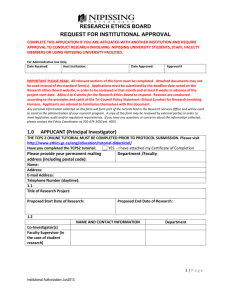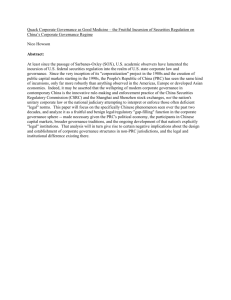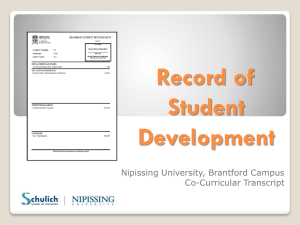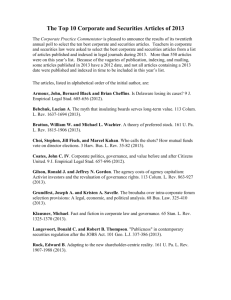IDC4U2 Course Outline 2014 (with itinerary)
advertisement
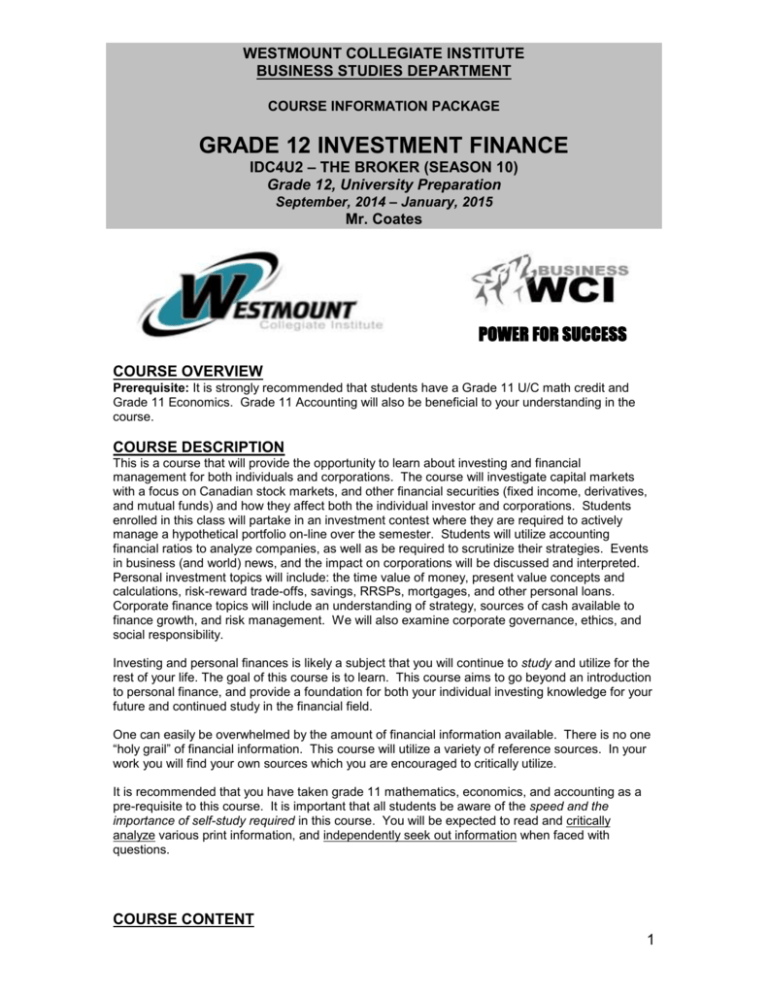
WESTMOUNT COLLEGIATE INSTITUTE BUSINESS STUDIES DEPARTMENT COURSE INFORMATION PACKAGE GRADE 12 INVESTMENT FINANCE IDC4U2 – THE BROKER (SEASON 10) Grade 12, University Preparation September, 2014 – January, 2015 Mr. Coates POWER FOR SUCCESS COURSE OVERVIEW Prerequisite: It is strongly recommended that students have a Grade 11 U/C math credit and Grade 11 Economics. Grade 11 Accounting will also be beneficial to your understanding in the course. COURSE DESCRIPTION This is a course that will provide the opportunity to learn about investing and financial management for both individuals and corporations. The course will investigate capital markets with a focus on Canadian stock markets, and other financial securities (fixed income, derivatives, and mutual funds) and how they affect both the individual investor and corporations. Students enrolled in this class will partake in an investment contest where they are required to actively manage a hypothetical portfolio on-line over the semester. Students will utilize accounting financial ratios to analyze companies, as well as be required to scrutinize their strategies. Events in business (and world) news, and the impact on corporations will be discussed and interpreted. Personal investment topics will include: the time value of money, present value concepts and calculations, risk-reward trade-offs, savings, RRSPs, mortgages, and other personal loans. Corporate finance topics will include an understanding of strategy, sources of cash available to finance growth, and risk management. We will also examine corporate governance, ethics, and social responsibility. Investing and personal finances is likely a subject that you will continue to study and utilize for the rest of your life. The goal of this course is to learn. This course aims to go beyond an introduction to personal finance, and provide a foundation for both your individual investing knowledge for your future and continued study in the financial field. One can easily be overwhelmed by the amount of financial information available. There is no one “holy grail” of financial information. This course will utilize a variety of reference sources. In your work you will find your own sources which you are encouraged to critically utilize. It is recommended that you have taken grade 11 mathematics, economics, and accounting as a pre-requisite to this course. It is important that all students be aware of the speed and the importance of self-study required in this course. You will be expected to read and critically analyze various print information, and independently seek out information when faced with questions. COURSE CONTENT 1 The following is a list of topics that represent the scope of this course. 1. Unit One: Capital Markets, Part One 25 hours An introduction to the structure and features of capital markets - both the users and the suppliers of capital and the intermediaries. Various basic financial securities will be studied, including the resultant risk / reward trade-offs, the mechanics of long short and margin accounts, and the resultant profit and loss calculations. A current Initial Public Offering will be studied. 2. Unit Two: Capital Markets, Part Two 25 hours More advanced financial securities will be studied, particularly options and futures derivatives. Mutual funds will be utilized to illustrate appropriate diversification and “stage in life” investment strategies. Fixed Income securities will be studied and will be used for the foundation to present and future value calculations of annuities. A current Initial Public Offering will be studied if not covered in Unit One. 3. Unit Three: Corporate Governance, Social Responsibility, and Ethics 15 hours Analysis of how business functions in relation to their various stakeholders. This will include the role and responsibility of Corporate Governance, its increasing importance and prevalence. Business ethics and corporate social responsibility will be studied with respect to a number of current real business examples. 4. Unit Four: Corporate Strategy and Financial Analysis 20 hours The students will study corporate strategy of a specific Canadian Public Company what and how the company is fulfilling their mission statement and corporate goals. First hand research will be part of this unit. The second half is to compare the past financial results of the study firm in conjunction with their qualitative strategy to a direct competitor in the industry with the goal of making an investment recommendation. 5. Unit Five: Independent Study/Seminar Unit 25 hours Students will be provided with guidelines of topics and format to independently research a topic that is of interest to them. Evidence of learning will include: a bulletin board display in the hallway of the school (outside Rm. 314) that “makes sense” to the average grade 10 student, a presentation of their research to their classmates and a written paper. Business is ever changing. To become current in business trends you are expected to read the newspaper on a daily basis (the Globe and Mail’s Report on Business, the business section in the Toronto Star, or the Financial Post within the National Post). EVALUATION UNIT 1 CAPITAL MARKETS UNIT TEST – PART ONE CURRENT ECONOMIC / FINANCIAL EVENTS PRESENTATION UNIT 2 PERSONAL PORTFOLIO REPORT CAPITAL MARKETS UNIT TEST – PART TWO UNIT 3 CORPORATE GOVERNANCE & ETHICS REPORT CARD ETHICS & CORPORATE GOVERNANCE IN-CLASS ESSAY UNIT 4 CORPORATE STRATEGY & FINANCIAL ANALYSIS UNIT TEST UNIT 5 INDEPENDENT STUDY PROJECT & SEMINAR FINAL REPORT COURSE MARK (NIPISSING STOCKMARKET) 10.0% 5.0% 5.0% 10.0% 10.0% 5.0% 10.0% 15.0% 30.0% 100.0% 2 Note: The Unit Tests, Presentations, Reports, Projects, and Seminars will be evaluated based on (1) Knowledge & Understanding, (2) Thinking & (3) Communication, and (4) Application of course content. The final course mark will reflect equal weighting of the four evaluation criteria. LEARNING SKILLS RESPONSIBILITY ORGANIZATION INDEPENDENT WORK COLLABORATION INITIATIVE SELF-REGULATION BEHAVIOUR/DESCRIPTORS completes and submits class work, homework, and assignments according to agreed-upon timelines punctual academic honesty devises and follows a plan and process for completing work and tasks establishes priorities and manages time to complete tasks and achieve goals preparedness uses class time appropriately to complete tasks follows instructions with minimal supervision responds positively to the ideas, opinions, values, and traditions of others shares information, resources, and expertise promotes critical thinking to solve problems and make decisions encourages and motivates others demonstrates the capacity for innovation and a willingness to take risks demonstrates curiosity and interest in learning actively participates in class sets own individual goals and monitors progress towards achieving them seeks clarification or assistance when needed takes responsibility for and manages own behavior stays on task As a university coded course, the final evaluation will cover all topics of the semester and will be weighted at 30% of the student’s final grade. GOOD LUCK – BEGIN WITH THE END IN MIND 3 GRADE 12 – INVESTMENT & FINANCE – IDC 4U2 THE BROKER, SEASON 10 – COURSE ITINERARY SEPTEMBER, 2014 – JANUARY, 2015 Week 1 September 3 – 5 Introduction to IDC4U2 (Canadian Securities Course) UNIT 1 CAPITAL MARKETS, Part 1 Overview of Investment Products (Debt, Equity, Mutual Funds, Derivatives) The Markets (Primary and Secondary) – The Listing Process Intermediaries Week 2 September 8 – 12 Investment Capital Suppliers of Investment Capital Sources of Capital The Financial Planning Process Principal Investment Objectives Managing Investment Objectives (Risk & Return) Users of Capital The Role of Financial Instruments The Role of Financial Markets (Auction Markets & Dealer Markets) The Role of Financial Intermediaries The Canadian Securities Industry – Principal & Agency Functions Week 3 September 15 – 19 The Canadian Securities Industry – Today Regulatory Organizations The Clearing Corporations & Industry Education Measuring the Economy The Business Cycle The External Sector Inflation – Effects on the Economy Interest Rates – Effects on the Economy The Exchange Rate – Effects on the Economy Economic Policy (Fiscal & Monetary Policy) Nipissing University Stockmarket Simulation - Group Selection & Registration Week 4 September 22 – 26 MONDAY, SEPTEMBER 22nd - P.A. DAY Investment Products: Equities Characteristics of Preferreds Types of Preferreds Preferred Features Assessing Preferred Share Investment Quality How Preferreds Fit into Individual Portfolios Rights & Advantages of Common Share Ownership Reading of Stock Quotes Current Economic / Financial Events Presentations (Daily) Nipissing University Stockmarket Simulation Week 5 September 29 – October 3 Cash & Margin Accounts Short Selling of Equities Current Economic / Financial Events Presentations (Daily) Nipissing University Stockmarket Simulation 4 Week 6 October 6 – 10 Buy & Sell Orders Current Economic / Financial Events Presentations (Daily) Nipissing University Stockmarket Simulation UNIT 1 CAPITAL MARKETS TEST (PART 1) Friday, October 10th Week 7 October 14 – 17 MONDAY, OCTOBER 13th - THANKSGIVING UNIT 2 CAPITAL MARKETS, Part 2 Issuance of Debt Securities Reading Bond Quotes Types of Bonds Bond Features Present & Future Value Calculations Bond Yield Calculations The Yield Curve and Bond Switching Delivery, Regulation, and Settlement Types of Investment Funds Mutual Funds – Types, Advantages, Disadvantages Current Economic / Financial Events Presentations (Daily) Wilfrid Laurier University Stockmarket Simulation Week 8 October 20 – 24 Buying Mutual Fund Securities Judging Mutual Fund Performance Unit Investment Trusts (UIT) Real Estate Investment Trusts (REIT) Mortgage Backed Securities (MBS) Investment Products – Derivatives Rights & Warrants Nipissing University Stockmarket Simulation Personal Portfolio Report – Due: Friday, October 24th Week 9 October 27 – October 31 PA Day – Monday, October 27th Options Futures & Forwards Fundamental Analysis Quantitative Analysis Technical Analysis Factors Affecting Securities Prices The Portfolio Process Nipissing University Stockmarket Simulation Week 10 November 3 – 7 Designing an Investment Policy Developing and Implementing an Asset Mix Evaluating Portfolio Performance CAPITAL MARKETS TEST (PART 2) – Friday, November 7th Nipissing University Stockmarket Simulation Week 11 November 10 – 14 UNIT 3 CORPORATE GOVERNANCE, SOCIAL RESPONSIBILITY & ETHICS Role & Responsibility of Corporate Governance Regulation & Investor Protection / Self Regulatory Organizations Necessity for Ethical Trading and Conduct Business Ethics, Corporate Social Responsibility Nipissing University Stockmarket Simulation Friday, November 14th – PA DAY 5 Week 12 November 17 – 21 Wall Street & Rogue Trader Work on Corporate Report Card Report Tentative Field Trip to The Degroote School of Business (McMaster University) Nipissing University Stockmarket Simulation Week 13 November 24 – 28 IN-CLASS ETHICS ESSAY – Wednesday, November 26th Work on Corporate Report Card Report Week 14 December 1 – 5 CORPORATE REPORT CARD DUE – Monday, December 1st UNIT 4 CORPORATE STRATEGY & FINANCIAL ANALYSIS Mission Statements, Vision, & Strategy Understanding Financial Statements Balance Sheets Classification of Assets, Liabilities, and Shareholder’s Equity Week 15 December 8 – 12 The Income Statement Retained Earnings Statement Statement of Changes in Financial Position The Annual Report Interpreting Financial Statements (Liquidity, Debt, Profitability, & Value) Week 16 December 15 – 19 CORPORATE STRATEGY & FINANCIAL ANALYSIS UNIT TEST – Monday, December 15th (Part A & B) & Tuesday, December 16th (Part C & D) CHRISTMAS HOLIDAYS – DECEMBER 20th – JANUARY 4th 2015 Week 17 January 5 – 9 ISU SEMINARS Week 18 January 12 – 16 ISU SEMINARS Week 19 January 19 – 22 ISU SEMINARS FINAL STOCKMARKET REPORTS DUE: Thursday, January 22nd 2015 @ 3:20:00 p.m. (no exceptions) 6
